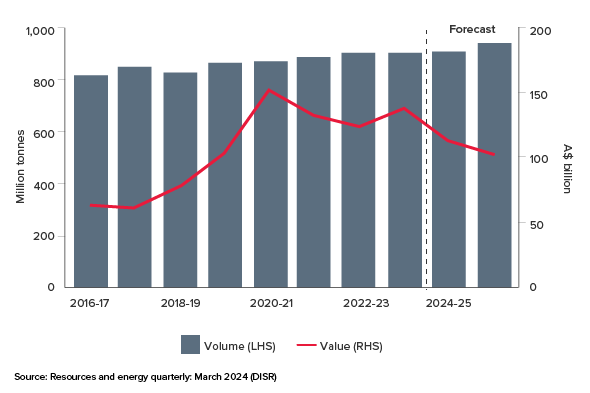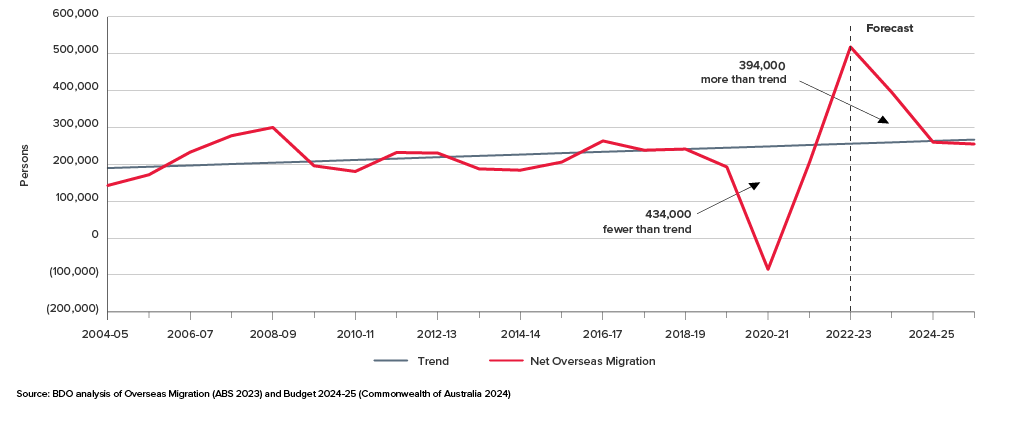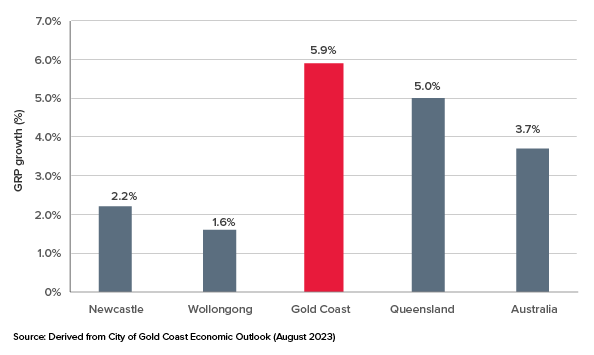An update on the Australian economy
An update on the Australian economy
Megatrends are substantial and potentially transformative trajectories of change that play out over decades. They are often the drivers behind local issues and pose significant risks and opportunities for small economies that punch above their weight, like Australia.
Recently, we presented an economic update at the Gold Coast North Chamber of Commerce Luncheon, discussing the latest trends driving the Australian economy and what they mean for the general population and, more directly, the Gold Coast and Queensland.
In this article, we explore how global megatrends manifest as trends and drivers of the Australian economy while providing a snapshot of its current state.
Understanding the global megatrends
To understand the impacts of global megatrends on the Australian economy, we outline four key themes below that are currently presenting risks and opportunities and playing an influential role.
- The global population is aging, and people are demanding more and better quality health services, with relatively fewer working-aged people to pay for them.
- The impacts of climate change are already emerging, and the net zero transition is ramping up.
- The global power balance is shifting from the United States (US) as a single power to multiple competing powers. China overtook the US in terms of total gross domestic product (GDP) in 2017, and India is steadily catching up, too.
- Digital and Artificial Intelligence (AI) will immediately, significantly, and persistently impact the global economy.
Our view on how these key trends influence the Australian economy is outlined below.
How are international influences affecting the Australian economy?
It’s no secret that China has a clear and persistent influence on Australia's economy, particularly our mining revenue as its growth feeds demand for our iron ore and coal. This has worked well for both Australia and China for decades. However, China’s growth is slowing, and our iron ore revenue is decreasing as shown in the chart below, as its economy advances and shifts towards domestic services and consumption driven by the growing middle class. The silver lining for Australia is that we can continue to sell our iron ore and coal to China, however, we can also leverage the growing opportunities in services like tourism, education, and health.
Australian iron ore exports

The global net zero transition offers opportunities to leverage our resources, such as critical minerals and renewable energy, to support global electrification and green manufacturing such as green steel. Governments, including Australia’s, are incentivising investments in these areas through subsidies and tax concessions to gain a head start in global green supply chains.
However, focusing investments on the wrong projects could create an industry that depends on government subsidies for survival. In other words, if we don’t make the right choices, we will end up with a handicap rather than a head start.
Australian economic trends
An aging population
Australia is not exempt from experiencing the demographic aging megatrend. The latest Intergenerational Report from the Productivity Commission shows the proportion of older people is increasing relative to the working-age population, driving demand for more and better healthcare services while reducing our ability to afford them.
To address these increasing needs, we must look beyond healthcare to achieve better health outcomes. While healthcare is important and we need to accelerate productivity in order to afford it, well-considered policy and infrastructure design can also improve Australia’s health outcomes. Urban design, transportation, green spaces, community organisations, arts and culture all play a role. While our population is aging, it’s not expected to be as extreme as that of most Organisation for Economic Cooperation and Development (OECD) member countries, giving us a relative advantage.
The need for productivity improvements will be an uphill battle, with productivity growth having slowed over the past couple of decades. The Intergenerational Report from the Productivity Commission revised the expected productivity growth rate from 1.5 to 1.2 per cent. So, how do we accelerate it?
There are many contributing factors and no simple solution. We suggest a range of targeted actions, including:
- Enhancing competition policy
- Improving skills and training policy
- Better utilising the skills of our migrants, including secondary migrants who accompany primary skilled migrants
- Adopting digital solutions and AI
- Making better informed decisions about our hard and soft infrastructure investments.
Climate change impacts
The changing climate presents risks and perhaps also some opportunities for Australia. Economically, we face reduced agricultural productivity, increased property damage, higher insurance premiums, risks to coastal infrastructure, and more health issues from heat stress and extreme weather. However, opportunities exist for those who invest ahead of the change. For example, as optimal winegrape growing regions shift closer to the poles in a warming climate, businesses are investing in land that is expected to become productive in the future. We should all consider whether our current plans make sense in a warmer world with more extreme weather events.
The economy today
Housing supply
Housing shortages are currently at the forefront of Australians’ minds. For two decades before the global pandemic, Australia’s housing stock grew at a slower rate than the population, leading to an undersupply. When the pandemic hit, Australians’ preferences for the number of people per household slightly decreased, which meant we needed 120,000 more households for the same population. This could have been a problem had we not closed borders, preventing new migrants from arriving, meaning there were enough houses to meet this new demand.
However, the Government continued issuing visas at the same rate as pre-pandemic. When the borders reopened and these migrants arrived, housing vacancies dropped quickly. This was only a ‘catch-up’ wave of migration as opposed to any real increase, as evident on the chart below where net overseas migration (the red line) drops below the trend (the grey line) while the borders were closed, then climbs above it again by the same amount to complete the catch-up. The forecast represents the Australian Government’s expectations.
Net overseas migration

Although the wave is now passing, Australia still faces a housing shortage due to continuing undersupply and a preference for smaller household sizes. There are no quick fixes. We need sustained effort and investment to win this battle in the medium term while prioritising our most vulnerable people in the short term.
Workforce shortages
During the pandemic, unprecedented government spending stimulated the economy and, combined with a lack of migration due to closed borders, led to workforce shortages. The fact that the recent wave of migration was only a 'catch up' explains why we haven’t seen a big increase in unemployment, just a steady return to normal. Our expert's forecast for unemployment aligns with the Reserve Bank of Australia’s (RBA’s) forecast, increasing only marginally over the next year. So, it will likely only get a little easier for businesses that are trying to find workers.
Growth in Australia has been slow for a couple of years and is expected to increase a little over the next year. GDP per capita has been negative (or close to it) for a couple of years, which is due as much to the catch-up wave of migration over that period as it is to slow growth. As forecast by the RBA, inflation is coming down. We predict that we'll be in our current state of waiting and watching for another year, with some cautious cash rate reductions by the RBA in early 2025. Consequently, we don’t expect consumers to have any more real money in their pockets until this time next year.
A spotlight on the Gold Coast and Queensland
China is Queensland’s largest trading partner, export market, source of imports, source of international students and tourists, and is an important investor in the state. However, the US and Japan are more important export markets for the Gold Coast, particularly as market destinations for manufactured goods like food and alcohol, and machinery and equipment. These markets are also important export destinations for professional services, technology and health. However, China's growing services economy is good news as it creates opportunities for the Gold Coast, particularly in tourism, education, and health.
The population of people over 65 is growing substantially on the Gold Coast, slightly faster than Brisbane and in line with the Sunshine Coast. However, younger age groups are also growing relatively quickly, meaning the imbalance between working-age and older people will be less severe in the Gold Coast compared to elsewhere in Queensland and Australia. The Gold Coast has the advantage of being relatively prosperous, meaning people will be better able to afford the healthcare services they demand. Affording healthcare is only part of the solution, so businesses and the Government should consider how they can support improved health outcomes, particularly for the over 65 age group.
Year-on-year growth rate (2021 to 2022)

The graph above shows that slow growth is not a problem on the Gold Coast. It's growing faster than comparable regional cities such as Wollongong and Newcastle and faster than Queensland and Australia as a whole. However, fast growth can lead to poor health and wellbeing outcomes if the urban environment is not carefully planned. This makes planning for a healthy city even more important.
Conclusion
To understand the Australian economy, it’s essential to first understand the global megatrends. Aging populations, international influences, housing and workforce shortages are all currently driving the Australian economy. Strategic investments and well-considered policy and infrastructure design are imperative to improve Australia’s increasingly important health outcomes.
Our economics team helps decision-makers from all levels of government, industry associations, development boards and not-for-profit organisations. Contact us to find out how we can support you.